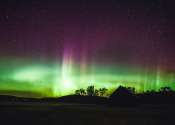A solar flare is a big explosion in the Sun's atmosphere that can release as much as 6 × 1025 joules of energy. The term is also used to refer to similar phenomena in other stars, where the more accurate term stellar flare applies.
Solar flares affect all layers of the solar atmosphere (photosphere, corona, and chromosphere), heating plasma to tens of millions of kelvins and accelerating electrons, protons, and heavier ions to near the speed of light. They produce radiation across the electromagnetic spectrum at all wavelengths, from radio waves to gamma rays. Most flares occur in active regions around sunspots, where intense magnetic fields penetrate the photosphere to link the corona to the solar interior. Flares are powered by the sudden (timescales of minutes to tens of minutes) release of magnetic energy stored in the corona. If a solar flare is exceptionally powerful, it can cause coronal mass ejections.
X-rays and UV radiation emitted by solar flares can affect Earth's ionosphere and disrupt long-range radio communications. Direct radio emission at decimetric wavelengths may disturb operation of radars and other devices operating at these frequencies.
Solar flares were first observed on the Sun by Richard Christopher Carrington and independently by Richard Hodgson in 1859 as localized visible brightenings of small areas within a sunspot group. Stellar flares have also been observed on a variety of other stars.
The frequency of occurrence of solar flares varies, from several per day when the Sun is particularly "active" to less than one each week when the Sun is "quiet". Large flares are less frequent than smaller ones. Solar activity varies with an 11-year cycle (the solar cycle). At the peak of the cycle there are typically more sunspots on the Sun, and hence more solar flares.









